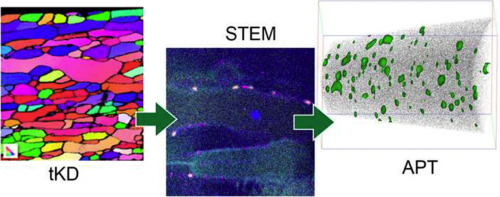当前位置:
X-MOL 学术
›
Scr. Mater.
›
论文详情
Our official English website, www.x-mol.net, welcomes your feedback! (Note: you will need to create a separate account there.)
Viewpoint: Nanoscale chemistry and crystallography are both the obstacle and pathway to advanced radiation-tolerant materials
Scripta Materialia ( IF 6 ) Pub Date : 2018-01-01 , DOI: 10.1016/j.scriptamat.2017.05.014 Chad M. Parish , Kun Wang , Philip D. Edmondson
Scripta Materialia ( IF 6 ) Pub Date : 2018-01-01 , DOI: 10.1016/j.scriptamat.2017.05.014 Chad M. Parish , Kun Wang , Philip D. Edmondson

|
Abstract New candidate materials for GenIV or fusion nuclear energy systems, e.g., nanostructured ferritic alloys, are distinguished from older-generation nuclear materials by much smaller feature sizes and complex local nanochemistry and crystallography. Established and perspective nuclear materials, e.g. reactor pressure vessel steels or plasma-facing tungsten, also form small nanoscale structures under in-reactor service. Here, we discuss recent advances in materials characterization – high-efficiency X-ray mapping combined with datamining; transmission Kikuchi diffraction; and atom probe tomography – that make it possible to quantitatively characterize these nanoscale structures in unprecedented detail, which enables advances in understanding and modelling of radiation service and degradation.
中文翻译:

观点:纳米化学和晶体学是先进耐辐射材料的障碍和途径
摘要 GenIV 或聚变核能系统的新候选材料,例如纳米结构铁素体合金,与老一代核材料的区别在于更小的特征尺寸和复杂的局部纳米化学和晶体学。成熟的和有前景的核材料,例如反应堆压力容器钢或面向等离子体的钨,也在反应堆内使用时形成小的纳米级结构。在这里,我们讨论了材料表征的最新进展——高效 X 射线映射与数据挖掘相结合;透射菊池衍射;和原子探针断层扫描——这使得能够以前所未有的细节定量表征这些纳米级结构,从而促进对辐射服务和退化的理解和建模。
更新日期:2018-01-01
中文翻译:

观点:纳米化学和晶体学是先进耐辐射材料的障碍和途径
摘要 GenIV 或聚变核能系统的新候选材料,例如纳米结构铁素体合金,与老一代核材料的区别在于更小的特征尺寸和复杂的局部纳米化学和晶体学。成熟的和有前景的核材料,例如反应堆压力容器钢或面向等离子体的钨,也在反应堆内使用时形成小的纳米级结构。在这里,我们讨论了材料表征的最新进展——高效 X 射线映射与数据挖掘相结合;透射菊池衍射;和原子探针断层扫描——这使得能够以前所未有的细节定量表征这些纳米级结构,从而促进对辐射服务和退化的理解和建模。



























 京公网安备 11010802027423号
京公网安备 11010802027423号